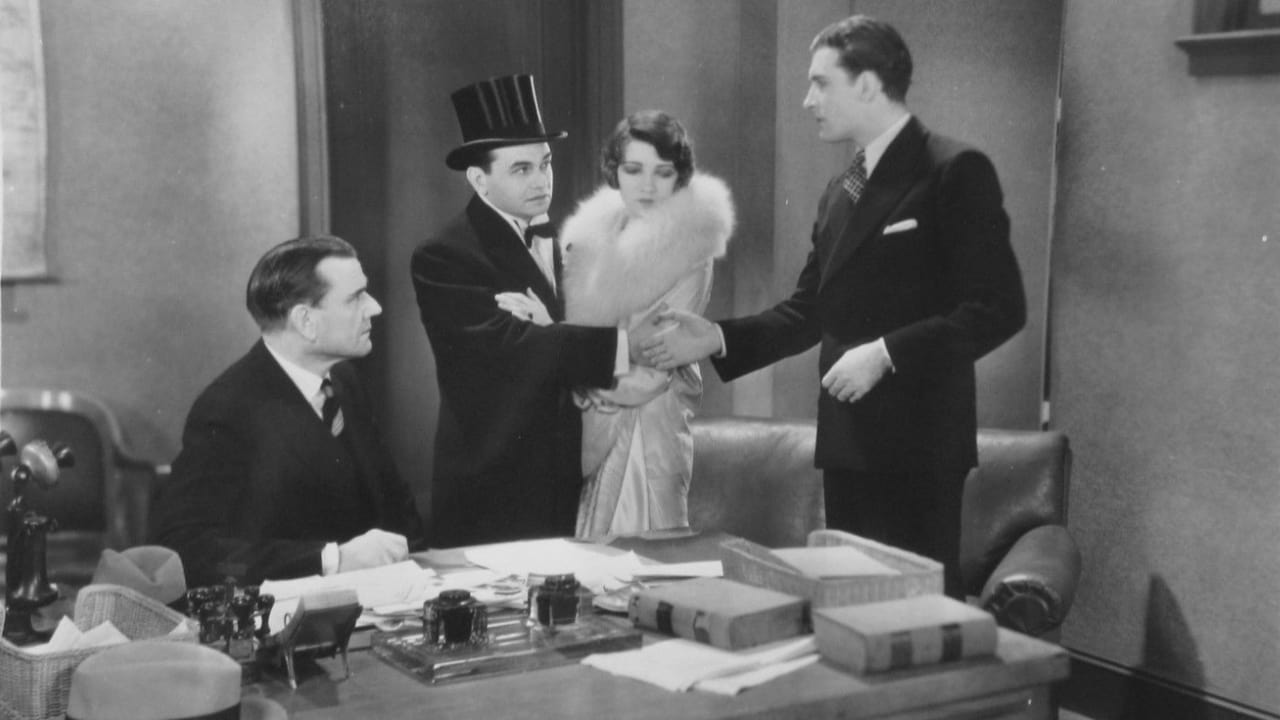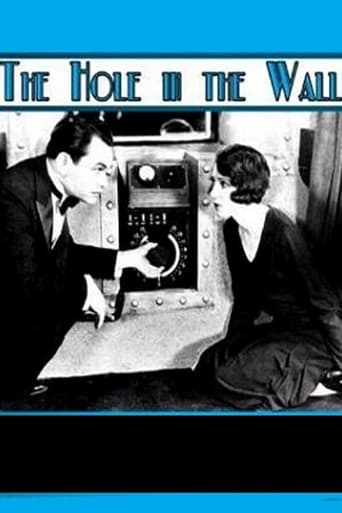



Plot so thin, it passes unnoticed.
Perfectly adorable
Best movie ever!
Unshakable, witty and deeply felt, the film will be paying emotional dividends for a long, long time.
View MoreThe Great Depression put an end to the huge onslaught of Broadway mystery and suspense plays which reached a peak in 1927. These plays do not generally translate at all well as film noir, although exceptions can be made for The Bat (1926) and The Hole in the Wall (1930). The film version of "The Hole in the Wall" was formerly available on a most interesting VintageFilmBuff DVD. You've all heard of a part-talkie. Well, the VFB release is actually a part-silent, roughly 95% talking, yet 5% silent — and by "silent" I mean dead silent. Except for two sequences, namely music in a night club, and crash effects in the El — there is absolutely no sound at all in the silent action footage that is cut into the movie from time to time. However, 'The Hole in the Wall' does most effectively showcase some really spooky sets. These alone make the movie worth viewing. The characters are somewhat creepy too, but the screenplay chickens out on allowing them to reach their full noir potential. Particularly disappointing is the "geek" (v. Nightmare Alley) who is given a great build-up as a potential menace (and even enacts that part in a publicity still with Donald Meek), but is then allowed to slip away into almost nothing. Edward G. Robinson, of course, is at home as the heavy with a heart, while Claudette Colbert looks appropriately unglamorous as the revengeful convict-turned-fake-mystic.
View MoreThe Hole in the Wall (1929)** (out of 4)Edward G. RObinson plays a man known as The Fox, the leader of a group of thieves. They get away with so many crimes due to help from a psychic but when she is killed the leader fears their criminal days are over. That's until they meet Jean Oliver (Claudette Colbert) who agrees to help them as long as they help her kidnap a child from a woman who caused her to go to jail.THE HOLE IN THE WALL is a pretty ridiculous drama story that should have been re-written a few times before it was actually filmed. THe film has pretty much been forgotten today except to those who want to see two future legends in their talkie debuts. While the film is pretty stupid all around, the appeal of the two stars makes it worth watching.As I said, the screenplay here is certainly the worst thing about the picture as the entire thing is just way too dumb to make you actually care about anything going on. The entire thing with the psychic just doesn't work and at times it becomes rather laughable. I'm guess since this was an early talkie the screenwriters just through everyone would be caught up in the dialogue that they wouldn't pay attention to how silly the story was.The one good thing about the film is that it clocks in at just 63- minutes so it's certainly over before you know it. Both Robinson and Colbert are decent enough in their roles but I'm not sure anyone watching this in 1929 would have guessed that they'd go on to become legends.
View MoreThe plot for "The Hole in the Wall" is utterly ridiculous and I am pretty sure that audiences back in 1929 must have thought so as well. Sometimes you can still enjoy a ridiculous film...but this strains anyone's ability to suspend disbelief!When the film begins, a gang of thieves is stuck. Their fake psychic partner is dead and unless they can find a new one, they'll have to disband or get real jobs. When Jean (Claudette Colbert) arrives on the scene, the boss (Edward G. Robinson) thinks perhaps she has the talent to be their next 'Spiritual Adviser'. She agrees with one condition--that they also kidnap Mrs. Ramsey's young daughter. It seems that Ramsey had sent Jean to prison when she was innocent and now Jean wants revenge. But instead of selling back the kid, she plans on raising the kid to be a little crook in order to get her revenge!!! Talk about complicated and wildly improbable!! Even more improbably, Jean writes a letter to Ramsey telling her of her plan!!! Who would be that stupid?!?!So is this any good? Not really, but for fans of classic Hollywood, it does give them a chance to see Robinson and Colbert in their first talking picture. Neither were famous at this point and it was only Robinson's third film and Colbert's second and she looks far different than she would in the 1930s-40s. Still, Colbert is pretty natural on screen, but unfortunately Robinson is rather flat. His usual bluster and bigger than life persona is absent and the character is a bit dull despite being the gang's leader. In fact, the whole film is very flat and lacks excitement where it should be.
View MoreBoth Claudette Colbert and Edward G. Robinson were stars of the stage when Paramount's Long Island Studios contracted them to star in "The Hole in the Wall", a gritty crime drama dealing with kidnapping and spiritualism. Colbert had initially been the darling of Broadway for her performance in "The Barker" (225 performances) but a succession of bad plays and the advent of talking pictures made her reconsider her decision about the movies. (She had made a silent "For the Love of Mike" (1927) and absolutely hated it.) Robinson only accepted the role of "The Fox" because the deal was lucrative - he didn't like the script or the second billing to Miss Colbert.By mid 1929 a lot of people were despairing of talkies - they were static and action was only a word that directors used to commence a scene. Apart from an initial "talkie" sequence, the film opens with a pretty spectacular train derailment, with super imposed images of screaming people, flames and rescue workers. Among the dead is Madame Mysteria, a vital part of "the hole in the wall" gang, headed by "The Fox" (Edward G. Robinson), a bunch of jewel thieves, who steal from the wealthy society people that are drawn to Madame Mysteria's readings. Without Madame, the group is foundering but suddenly Jean Oliver (Claudette Colbert) appears at their headquarters. She has just spent 4 years in prison on a trumped up larceny charge. She was framed by her employee, Mrs Ramsey (Louise Closser Hale), a bitter woman who was jealous of her son's constant attention to Jean. Meeting one of the Fox's gang in prison, she arrives at the Hole in the Wall, eager for a job and with revenge in her heart. She has already developed a plan to kidnap her former employer's grand daughter, "bring her up to lie, cheat and steal and when she comes before a Judge, I can say to Mrs. Ramsey, behold your grand daughter!!!" The Fox installs her as the new Madame Mysteria, the real Madame he identifies as Jean Oliver. Meanwhile a newspaper reporter, (Jean's old childhood sweetheart) (David Newell) is putting two and two together - linking recent robberies with spiritualist Madame Mysteria.The sets are a combination of Art Deco and Expressionistic "Dr. Caligari" types - many of these very old movies had futuristic sets. Colbert and Robinson both seemed to learn on the job. Robinson's first scene - he seemed to speak very slowly and in Colbert's she seemed pretty jittery and didn't know what to do with her hands. To give Colbert her due, she was saddled with a "Oh Woe is Me" speech and had to put her hand to her brow!! Fortunately the plot thickened in the last 20 minutes - including a child being snatched from a watery grave and a character called "Dogface", a mad man locked in his room, who didn't seem to serve any purpose to the plot, except at the end when he springs into action. Midway through the film, Colbert and Robinson had relaxed enough in their acting to look as though they definitely had a future in talkies.One person who didn't was David Newell. There was obviously a reason why Paramount dropped him from their roster. As Jean's childhood love, he was very wooden and uptight. I have also seen him in another early talkie, "Darkened Rooms" (I wonder what that one was about - could it have been "phoney mediums")!! It was made by Paramount at the end of 1929 and his acting hadn't improved.Recommended.
View More